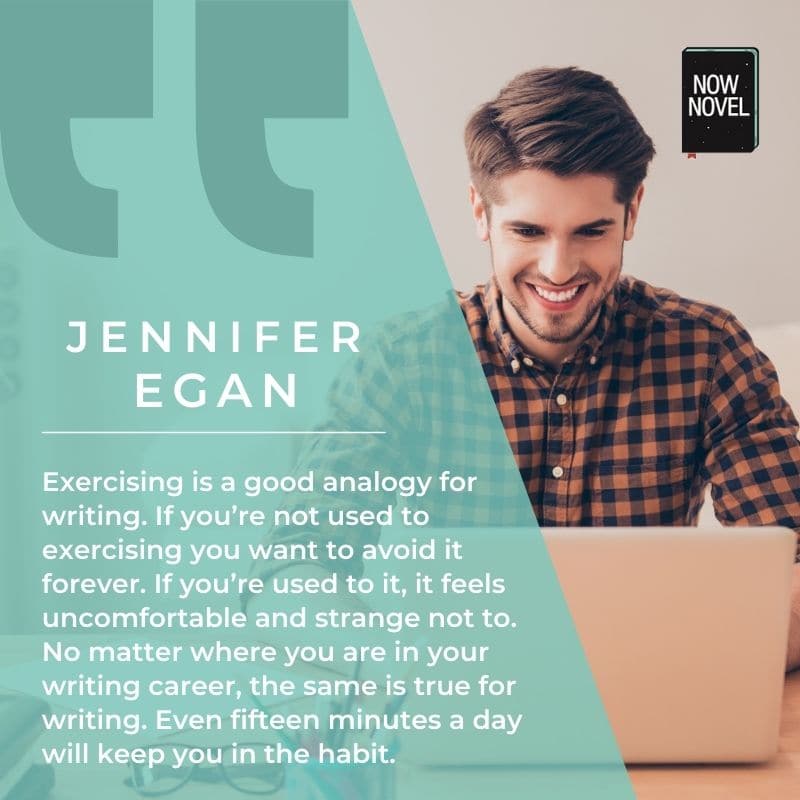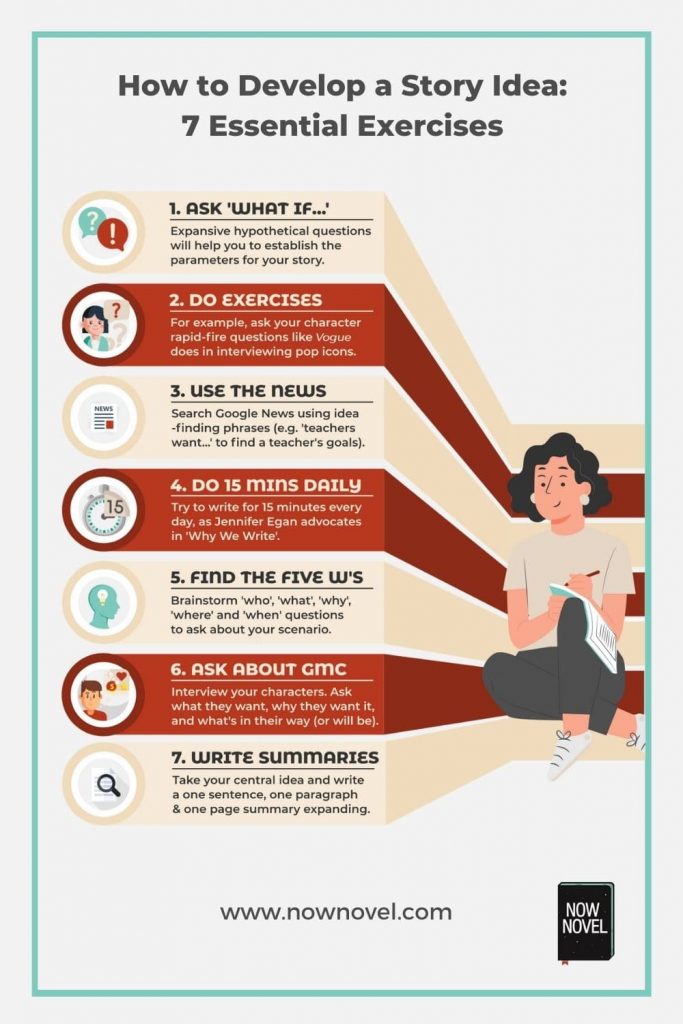Learning how to develop a story idea comes with practice and staying curious. These 7 story development exercises will help you ask questions and flesh out rudimentary ideas with greater substance and detail:
How to develop your story from first ideas:
- Ask expansive, hypothetical questions
- Do character development exercises
- Use the news to develop story ideas
- Do your fifteen minutes a day
- Be a journalist about the Five Ws
- Ask your characters about their GMCs
- Write a two-line, page and paragraph summary
Let's explore story development futher:
Ask expansive, hypothetical questions
Hypothetical questions are incredibly useful for expanding fleeting ideas into fuller concepts.
Neil Gaiman has written about how to develop a story idea by asking 'What if...':
You get ideas when you ask yourself simple questions. The most important of the questions is just, What if…?
(What if you woke up with wings? What if your sister turned into a mouse? ...)
Neil Gaiman, 'Where do you get your ideas?', via the author's essays on his website.
Gaiman is writing about how to find an initial idea, of course, but the same process can help you find interesting story development questions once you have your primary story idea.
Story development exercise: Active daydreaming
Take your basic story idea (if you don't have an idea or would like to try a new one, use the free Central Idea section of Now Novel's outlining dashboard).
Brainstorm five 'what if...' questions inspired by this idea and its parameters. Here's an example using the blurb for Stephen King's Billy Summers (2021):
King's Story Idea: A killer for hire who only takes out bad guys seeks redemption as he does one final job.
What if:
- The key bad guy for the final job is actually a really good guy and the killer finds out too late?
- The final job involves taking out a close friend or confidant?
- The killer misunderstands the brief for the final job?
- The final job goes wrong and the killer's own life is on the line?
- The killer for hire is made a rival offer he cannot refuse?
Try to imagine an answering 'Then...' statement for each of the what if questions you come up with.
Do character development exercises
When asked how to develop a story idea, many authors mention interviewing their characters or creating questionnaires.
Take, for example, the story idea above, the core idea for Stephen King's Billy Summers. Knowing these story parameters, you could ask the anti-hero killer main character:
- Why did you become a killer for hire?
- Why do you only take out 'bad guys'?
- What's your definition of a 'bad guy'?
- What does 'redemption' mean to you?
- Who deserves redemption?
Brainstorm your own character development questions and use them to look deeper into the characters outlined in your central idea - their goals and the motivations underlying them. Start thinking deeper about conflicts that could arise from these details.
Exercise: Character development in Vogue
Vogue magazine often interviews celebrities in a video format where they ask many questions drawn from the individual's vocation or body of work in rapid-fire succession. For example, when they asked singer Lorde 'what's the first song that made you cry?'
Think of a main character and their main interests, hobbies or specialization. Now write a list of 10 questions to ask them. Try to think of questions that reveal:
- Emotional highs or lows
- First or most recent experiences
- Values, judgments or prejudices
- Desires and fears
Use the news to develop story ideas
Google News is a great tool for developing story ideas when you're looking for simple inspiration.
You may want to be careful with what you search, since news articles may return disturbing true stories. However, searching a term based on Stephen King's Billy Summers, 'killer for hire', returns this headline:
'Dallas woman, 49, charged in airline exec husband's murder-for-hire'
This loaded headline could provide many ideas to develop Stephen King's story idea, for example:
- The person the killer is contracted to kill is a powerful business executive
- The intended target of the assassination is actually innocent and the hit is the result of an affair (like in the news story)
This is a useful exercise for finding subplots, too.
Say, for example, your protagonist is a teacher. You could find a subplot for a potential conflict by searching phrases implying struggle such as 'teacher struggles with' or 'teacher can't'. Examples this yields:
- New Mexico struggles with teacher vacancies
- Cerebral palsy can't stop Knox County teacher
This process might inspire a new idea for a subplot. For example, your story's protagonist may have a disability that makes it more challenging to navigate school premises that weren't built with the differently abled in mind.
Story development exercise: Rewrite the news
Pick a main character's job or favourite subject. Go to Google News and search for this word plus 'wants to'.
Write down the headline, then try to come up with five other possible character goals inspired by this line.
For example, let's take 'musician wants to':
Headline: Embracing vitiligo: Ugandan artist dispels skin stigma with portraits
We have a potential challenge for an artist: Making it in a world where there is stigma about one's apperance such as racism or colorism. Five more goals out of this could be:
- The artists wants to host an exhibition featuring other musicians and people who look 'different' from norms
- The artist wants to start a dialogue with an immature audience member who heckles them
- The artist intends to have a global hit song within the next 5 years, referencing the stigma they've faced as an agent of change
This story development exercise will help you find ideas for primary or secondary goals in your characters' arcs.

Do your fifteen minutes a day
Developing story ideas gets easier with practice. Like Olympic training, good writing exercise is not a one off.
Jennifer Egan writes:
Exercising is a good analogy for writing. If you’re not used to exercising you want to avoid it forever. If you’re used to it, it feels uncomfortable and strange not to. No matter where you are in your writing career, the same is true for writing. Even fifteen minutes a day will keep you in the habit.
Jennifer Egan, quoted by Maria Popova in 'Jennifer Egan on Writing, the Trap of Approval, and the Most Important Discipline for Aspiring Writers'
Shortly after this, Egan describes how important it is to make peace with 'bad' writing, too.
Fifteen minutes per day might not be enough to write a full, polished chapter. So go easy on yourself - it's enough to develop ideas further and make a start.
Exercise: The power of 'because'
Set a timer for fifteen minutes (use your smartphone or search 'timer' in Google for the built-in timer tool).
Write down a statement about one of your characters before you start. This could be a simple 'Sarah is ...' type of statement ('Sarah is a badass', 'Sarah is ecstatic', etc.).
Start the timer and continue writing without stopping, only using 'because' to join on each clause. Don't censor yourself. Allow mistakes. Let your imagination run wild.
This is a useful way to free yourself from inhibitions while also developing chains of cause and effect that are important for a good story, in any genre.

Be a journalist about the 5 Ws
Journalists and fiction authors alike know that the 5 Ws are important for a good story: Who, what, why, where and when.
You can get so much mileage out of a simple two-line synopsis and turn it into something so much more substantial just by asking questions drawn from this quintet.
For example, given King's blurb for Billy Summers above, we could ask:
- Who is the contract killer's final target?
- What are the terms of the final contract that promises his redemption? (e.g. must he leave town forever, never to return?)
- Why does he only take out bad guys?
- Where will this final job take him (what are the location's own obstacles?)
- When must the hit be complete by?
Exercise: Investigative story development
Take your own story idea or one of the blurbs for NYT bestsellers listed by Hawes (Stephen King's blurb is from the report for October 10th, 2021).
Using the parameters of the idea, come up with five questions like the bullet list above, starting with who, what, why, where and when. Then try to answer these questions (don't censor yourself or edit - do this exercise fast).
Ask your characters about their GMCs
As kids, we learn our ABCs. Writers learn their GMCs - goals, motivations, and conflicts.
This simple triad of story elements supplies enough to develop a story idea extensively.
Often, when a writer struggles with how to develop a story idea it's because either they don't know what their characters want, what drives them, and what obstacles these goals and motivations could lead to, or other irrelevant scenes or incidents muddy the story's flow and sense of purpose.
Story development exercise: Learning your GMCs
To develop your idea, interview any characters you've brainstormed so far (or work through the steps in the Now Novel dashboard to create a character profile).
Ask your main characters:
- What do you want more than anything?
- Why do you want this?
- What's standing in your way now or might be in the future?
Write a two-line, one page, and one paragraph summary
Story development is an expansive process. This is a useful exercise both for writing a synopsis (when you are preparing to pitch your story) and for taking a basic idea and embellishing it, even before the full draft is written.
For additional dramatic structure, try to incorporate specific beats:
- The inciting incident: This is the event or situation that propels the story into motion. E.g. in Hitchcock's Rear Window (1954), the protagonist JB hears a woman scream, 'Don't!' followed by the sound of breaking glass.
- The first turning point or reversal: What happens that makes your protagonist change tack approach or acquire new goals?
- Rising action: What event or set of circumstances could increase narrative suspense, making your reader ask questions?
Reading like a writer is also a useful way to finetune and develop your instinct around incorporating story beats.
Try to turn your story idea into a paragraph and one page summary now. If you need further help, start developing stories step-by-step in the structured Now Novel dashboard.











Thank you so much, I learned a lot
Shirani Rajapakse - Over 3 years ago
I'm glad to hear that, Shirani. Thank you for reading our blog.
Jordan - Over 3 years ago